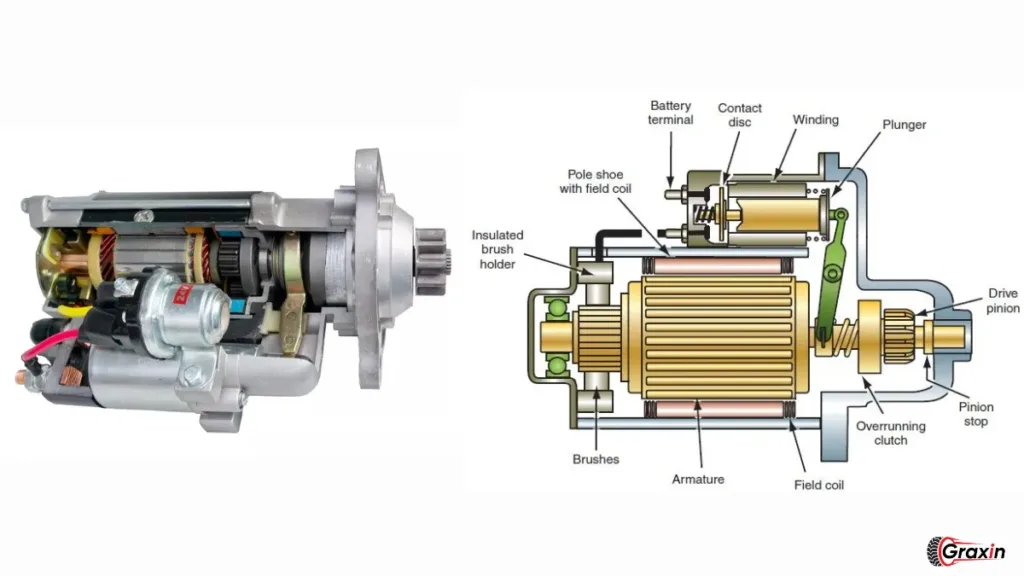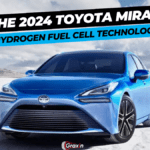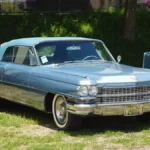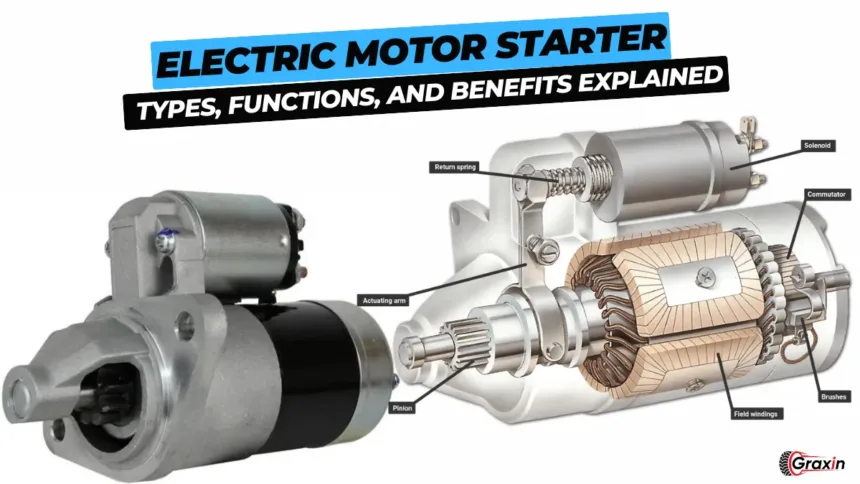Electric motors can be found in countless machines-house appliances to heavy industrial equipment. Have you ever thought about just how the motors get going or stay protected? That’s where the electric motor starter comes in. Whether a person is an engineer, a technician, or just simply curious, knowing how motor starters work might just prove to be a game-changer.
So let’s take a little deeper dive into what makes electric motor starters so important, the types of electric motor starters, and why you might be more surprised than you thought.
Introduction to Electric Motor Starters
If you ever tried to start a car or to operate heavy machinery, you know that turning a switch does not always activate things. Electric motors require not only a smooth starting but also a well-protection system while in operation. The electric motor starter is precisely used here.
An electric motor starter is that device which initiates and shuts down the function of an electric motor. It controls the current flowing to the motor and ensures that it does not get damaged in case of startup with the dangers of high levels of current, overheating, breakdowns, or permanent damage.
Why Are Electric Motor Starters Important?
And then there’s the question of why you can’t just flip the switch and let the motor just run along. The answer is in the nature of electric motors. You see, starting a motor with no starter would give an electrical surge in there. It would burn the windings or sometimes destroy some other internal part, something like trying to push a heavy boulder-you can’t just shove it full force right away. It must have a gradual accumulation of momentum. That is what an electric motor starter does for the former.
Key reasons for using motor starters include:
- Preventing motor overload.
- Protecting the motor from short circuits.
- Ensuring a smooth start and stop process.
- Controlling motor speed and current flow.
How Does an Electric Motor Starter Work?

In short, an electric motor starter acts very much like a traffic cop for electricity: regulating the flow of electrical current into the motor, so that the right amount gets to the motor when the application begins or continues running.
It usually includes a contactor that acts as an electrical switch and also incorporates overload protection. When the motor is started, current flows through it; the mechanism cuts off power supply to the motor when it exceeds a safe level with the aid of the overload protection device.
Components of an Electric Motor Starter
To understand the workings of an electric motor starter better, let’s break down its key components:
- Contactor: An electrically controlled switch that manages the current flow to the motor.
- Overload Relay: This device monitors the current and ensures it stays within safe limits. If the current becomes too high, the relay trips, cutting off power.
- Control Circuit: Governs how the starter operates, allowing for start, stop, and reset commands.
- Auxiliary Contacts: Used for additional signaling and control functions, such as turning on indicator lights or engaging other equipment.
Types of Electric Motor Starters
There are several types of electric motor starters, each serving specific needs and applications. Let’s explore the most common types:
Manual Motor Starters
These are the most basic type of starters, where a motor is manually switched on or off with the intervention of an operator. They protect against overload but are too simple for large and complex motors.
Magnetic Motor Starters
Magnetic starters automate the start and stop process using electromagnetic coils. They are more efficient than manual starters and provide better protection against overloads and short circuits.
Solid-State Starters
Solid-state starters use semiconductors to control the current flow, making them highly precise. They are ideal for applications where reducing mechanical wear and increasing energy efficiency is critical.
Direct On-Line (DOL) Starters
A DOL starter connects the motor directly to the power supply. While simple and cost-effective, they cause a significant inrush of current and are only suitable for smaller motors.
Star-Delta Starters
These starters reduce the initial current by connecting the motor in a star configuration at startup and later switching to a delta configuration during normal operation. They are commonly used for larger motors to reduce wear and tear.
Advantages of Using an Electric Motor Starter
Motor starters bring a range of benefits to the table:
- Protection from Overload: Starters protect the motor from excessive current and heat.
- Smooth Startup: They ensure the motor starts gradually, preventing jerks and mechanical damage.
- Prolonged Motor Life: By regulating the current, starters reduce stress on motor components, extending their lifespan.
- Enhanced Safety: Starters prevent hazardous electrical conditions that could lead to fires or equipment failure.
Common Applications of Electric Motor Starters
Electric motor starters are widely used in various industries, including:
- HVAC systems to regulate the startup and operation of large fans or compressors.
- Manufacturing plants to control conveyor belts and robotic arms.
- Pumps and compressors in water treatment facilities.
- Elevators and escalators for smooth operation and safety.
Choosing the Right Motor Starter for Your Needs
Selecting the right motor starter depends on several factors, including:
- Motor size and power rating.
- Required protection level.
- Operational environment (e.g., temperature, humidity).
- Starting and stopping frequency.
For smaller applications, a manual or DOL starter might suffice, but for larger systems, a magnetic or solid-state starter is often more appropriate.
Maintenance Tips for Electric Motor Starters
Regular maintenance ensures that your motor starter operates efficiently and safely. Here are some tips:
- Inspect for wear and tear regularly, especially on mechanical components like contactors.
- Check electrical connections to prevent overheating or arcing.
- Test the overload protection periodically to ensure it responds correctly.
Safety Considerations When Using Motor Starters
Safety is paramount when dealing with electric motors. Always:
- Ensure the motor starter is rated for your motor’s voltage and current.
- Use the correct type of starter for your application.
- Follow manufacturer guidelines for installation and maintenance.
How Electric Motor Starters Improve Energy Efficiency
An electric motor starter controls the flow of current and hence expends less energy during start-up or any form of actual use. Power factor starters are, most especially, energy-saving in operation; hence they can save cost over a period of time.
The Future of Electric Motor Starters
Advancements are being done on the motor starters to make them smart and efficient. IoT-enabled starters will come to help monitor and control motors remotely, improving efficiency and safety.
Real-Life Example of Motor Starter in Action
Suppose there is a manufacturing plant with conveyor belts that are powered through electric motors. If the factory does not use star-delta starters, then the belts in the system can be jerked violently at the time of startup, therefore causing damage to the system. The star-delta starter achieves the smooth startup of belts and motors for the factory and, therefore, optimizes energy consumption.
Conclusion
Unsung heroes of the machinery world, these electric motor starters carry the heavy load of safeguarding motors, efficiency, and smooth operations in almost all walks of life, from small home appliances to large industrial motors. A starter-merely a suitable one-is always crucial for performance as well as safety.
FAQs
1. What is the purpose of an electric motor starter?
An electric motor starter ensures a motor starts smoothly, controls the current, and protects it from overload or short circuits.
2. What are the types of electric motor starters?
Common types include manual, magnetic, solid-state, direct on-line (DOL), and star-delta starters.
3. Can I use the same motor starter for all motors?
No, you need to choose a motor starter based on the motor’s power rating, size, and application requirements.
4. How do I maintain a motor starter?
Regularly inspect it for wear, check electrical connections, and test the overload protection to ensure optimal operation.
5. Are motor starters energy-efficient?
Yes, especially solid-state starters, which regulate current flow and reduce energy consumption during motor startup.
Also Read : Power Steering Cooler: Everything You Need to Know







